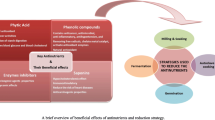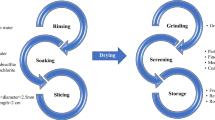Abstract
Protein digestibility was found to be 60.4 to 66.5 percent in raw unprocessed seeds of different pea cultivars. Protein digestibility (in vitro) was improved by the common methods of domestic processing and cooking including soaking, dehulling, ordinary cooking, pressure cooking and sprouting of legume grains. Pressure cooking had more pronounced effect on protein digestibility followed by ordinary cooking, sprouting, soaking for 18 h and (12 h) and dehulling. Pressure cooking of soaked and dehulled seeds was noticed to give most improved protein digestibility.
Similar content being viewed by others
References
Savage GP, Deo S (1989) The nutritional value of peas: A literature review. Nutr Abst Rev (Series) 59: 66–83.
Akeson WE, Stahmann MA (1964) A pepsin pancreation digest index of protein quality evaluation. J Nutr 83: 257–259.
Singh U, Jambunathan R (1981) Studies on desi and kabuli chick pea cultivars: The levels of protease inhibitors, level of polyphenolic compounds and in vitro digestibility. J Food Sci 46: 1364–1367.
Panse YG, Sukhatme PV (1961) Statistical methods of agriculture workers, 2nd ed. New Delhi: Indian Council of Agricultural Research, pp. 12: 87.
Khokhar S (1985) Studies on nutrient composition and antinutritional factors of moth bean (Vigna aconitifolia). MSc Thesis. Haryana Agricultural University, Hisar, India.
Sharma A (1989) Effect of processing and cooking methods on nutrient composition and antinutritional factors of Bakla (Vicia faba). MSc Thesis. Haryana Agricultural University, Hisar, India.
Jood S, Chauhan BM, Kapoor AC (1987) Polyphenols in chick pea and black gram as affected by domestic processing and cooking methods. J Sci Food Agric 38: 145–149.
Kataria A, Chauhan BM, Gandhi S (1988) Effect of domestic processing and cooking an antinutrients of black gram. Food Chem 30(2): 149–156.
Laurena AC, Garcia VV, Mendoza EMT (1987). Effect of heat on the removal of polyphenols and in vitro protein digestibility of cowpea (Vigna ungiuculata L.). Plant Foods Hum Nutr 37(2): 183–192.
Shrivastava PP, Das H, Prasad S (1990) Effect of roasting process variables on in vitro protein digestibility of bengal gram, maize and soybean. Food Chem 35: 31–37.
Kaur D (1986) Studies on nutrient composition and antinutritional factors of rice bean (Vigna umbellata). MSc Thesis. Haryana Agricultural University, Hisar, India.
Hamza MH (1983) Electrophoretic studies on seed protein of some Egyptian and German legume seeds. PhD Thesis. Faculty of Agriculture University of Alexandria.
Yousef MM, Abd-El, Ael MH, Laila AES, Ziena HM (1987) Effect of dehulling, soaking and germination on chemical composition, mineral element and protein pattern of faba bean (Vicia faba L.). Food Chem 23: 129–138.
Author information
Authors and Affiliations
Rights and permissions
About this article
Cite this article
Bishnoi, S., Khetarpaul, N. Protein digestability of vegetables and field peas (Pisum sativum). Plant Food Hum Nutr 46, 71–76 (1994). https://doi.org/10.1007/BF01088463
Received:
Accepted:
Issue Date:
DOI: https://doi.org/10.1007/BF01088463




